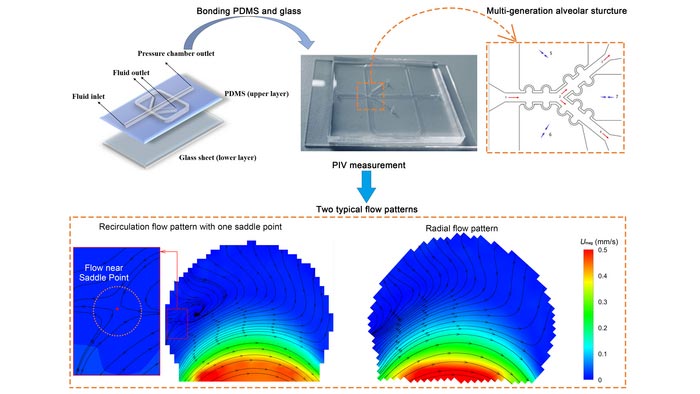Artificial breathing system reveals alveoli function in lungs

Schematic diagram of the alveolar chip (upper left), photograph of the chip (upper middle), CAD drawing of the multi-generation alveolar structure (upper right), and two typical flow patterns in the alveolar chip (bottom).
Credit: Yonggang Zhu
Chip mimics inhalation and exhalation, allowing scientists to study flow patterns in the bronchial network.
Alveoli are the basic functional units of the human respiratory system, acting as tiny air sacs that exchange gases. Air inhaled through the mouth and nose flows into the lungs through the branched structure of the bronchial tubes, and the alveoli appear in the deep sections of this network.
To fully understand and treat respiratory diseases, it is important to determine the flow pattern of air and particulates through the alveoli. In Biomicrofluidics, by AIP Publishing, scientists from the Harbin Institute of Technology in China created a model alveolar system that mimics the breathing action of the human lung and allows visualization of flow patterns within the alveoli.
The investigators designed a chip that includes tubes arranged like the structure of a bifurcation point in the bronchial network. The upper layer of the chip is made of a flexible polymer molded into small tubes that mimic the alveolar structure. The lower layer is glass, which allows the authors to visualize fluid flow through the tubes.
To mimic respiration, the scientists devised a system in which gas was pressurized in a sinusoidal fashion and pumped around the flexible tubes. This creates a breathlike cycle of inhalation and exhalation. To study flow patterns in the system, the group added small red polystyrene spheres to the fluid flowing through tubes. These spheres allowed them to photograph movement of the fluid as it was pushed through the tubes by the artificial breathing apparatus.
Subsequent branches in the bronchial network are known as generations, and the team found different flow patterns for different generations. In the human lung, alveoli appear at the 15th generation and remain present for generations up to 23. The researchers found a change in flow pattern between the 19th-20th and the 21st-22nd generations.
“The alveolar flow pattern of the 19th generation is dominated by vortex flow,” author Yonggang Zhu said. “Alveolar flow patterns in the 20th generation are similar to those in the 19th, but somewhat compressed.”
The investigators observed a change in the next generation.
“The alveolar flow pattern in the 21st generation has both vortex flow and radial flow. The vortex region is much smaller than the radial flow region. By the time the flow reaches the 22nd generation, vortex flow disappears completely, and we observe only radial flow,” Zhu said.
The authors also found evidence of chaotic behavior near the vortex center. They said more research is needed to fully understand this, but they felt the current study provides a good baseline for deeper investigations.
With the model, researchers will be able to study changes in flow patterns in the alveoli due to diseases such as emphysema and COPD.
The article “Microflows in two-generation alveolar cells at an acinar bifurcation” is authored by Yue Yang, Weitao Bai, Jun Dong, Huimin Lv, and Yonggang Zhu. The article will appear in Biomicrofluidics on Sept. 6, 2022 (DOI: 10.1063/5.0098302). After that date, it can be accessed at https://doi.org/10.1063/5.0098302.
ABOUT THE JOURNAL
Biomicrofluidics rapidly disseminates research in fundamental physicochemical mechanisms associated with microfluidic and nanofluidic phenomena. The journal also publishes research in unique microfluidic and nanofluidic techniques for diagnostic, medical, biological, pharmaceutical, environmental, and chemical applications. See https://aip.scitation.org/journal/bmf.
Journal: Biomicrofluidics
DOI: 10.1063/5.0098302
Article Title: Microflows in two-generation alveolar cells at an acinar bifurcation
Article Publication Date: 6-Sep-2022
Media Contact
Wendy Beatty
American Institute of Physics
media@aip.org
Office: 301.209.3090
All latest news from the category: Medical Engineering
The development of medical equipment, products and technical procedures is characterized by high research and development costs in a variety of fields related to the study of human medicine.
innovations-report provides informative and stimulating reports and articles on topics ranging from imaging processes, cell and tissue techniques, optical techniques, implants, orthopedic aids, clinical and medical office equipment, dialysis systems and x-ray/radiation monitoring devices to endoscopy, ultrasound, surgical techniques, and dental materials.
Newest articles

Pinpointing hydrogen isotopes in titanium hydride nanofilms
Although it is the smallest and lightest atom, hydrogen can have a big impact by infiltrating other materials and affecting their properties, such as superconductivity and metal-insulator-transitions. Now, researchers from…

A new way of entangling light and sound
For a wide variety of emerging quantum technologies, such as secure quantum communications and quantum computing, quantum entanglement is a prerequisite. Scientists at the Max-Planck-Institute for the Science of Light…

Telescope for NASA’s Roman Mission complete, delivered to Goddard
NASA’s Nancy Grace Roman Space Telescope is one giant step closer to unlocking the mysteries of the universe. The mission has now received its final major delivery: the Optical Telescope…



